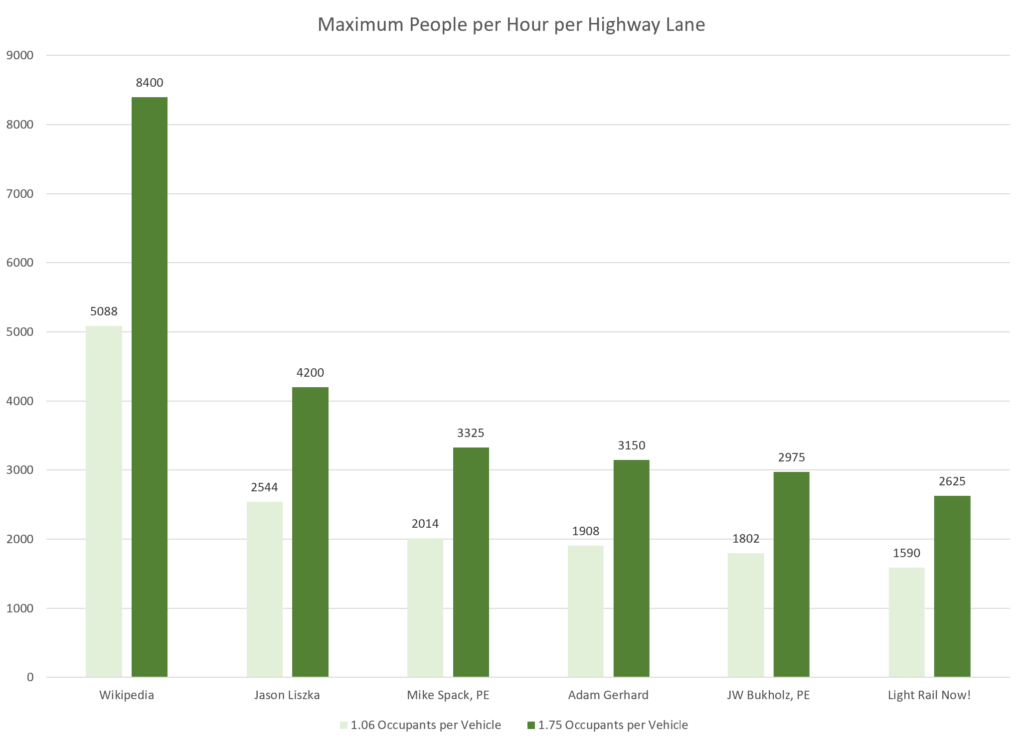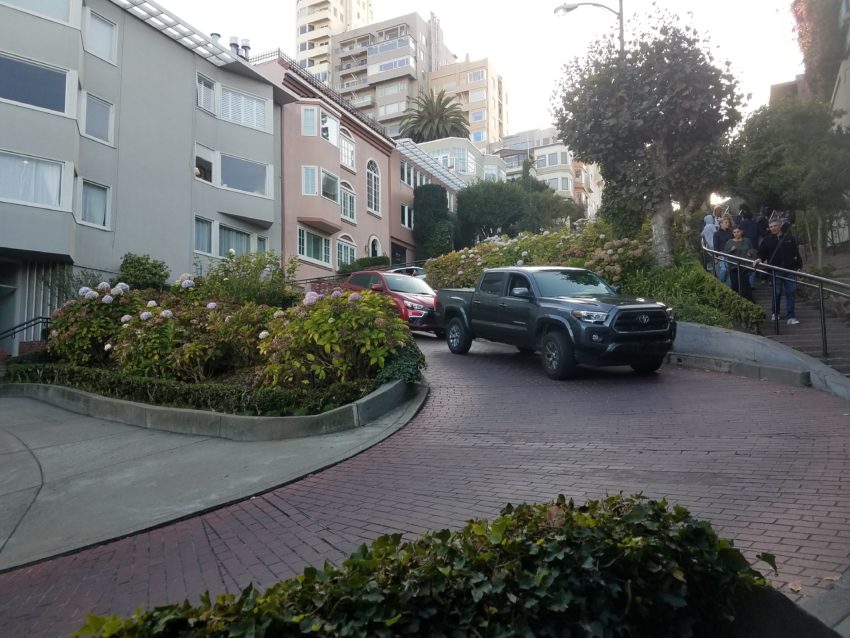Many people hail the arrival of the autonomous car as a solution that will alleviate traffic congestion by reducing accidents and allowing for coordinated and fluid motion of traffic. While these characteristics of future driving automation that are not yet possible may indeed help improve traffic they will not eliminate traffic jams nearly to the same degree as trains. Why? Because math. To begin lets start with the current numbers. Reality as we can best approximate it.
To get a fair comparison we will first look at the maximum passenger capacity of one highway lane and compare it with one train track at maximum current capacity. For automobiles this will require the combination of two numbers. The first number is the vehicles per hour per lane and the second number is the occupants per vehicle. For trains the numbers are usually given in people per hour per track so no conversion or combination is necessary.
Step 1: Highway Capacity

Maximum Automobile Flow
First lets deal with flow of cars in vehicles per hour per lane. The maximum numbers vary but 2,400 vehicles per hour per lane seems to be the highest number backed by a reasonable source and most studies of actual traffic find the peak flow at around 1,700 to 1,800 vehicles per lane per hour. This of course assumes ideal conditions.
- 1,500 to (4,800*no citation. Did not find any verification of this number) vehicles per hour per lane – “https://en.wikipedia.org/wiki/Lane”
- 1,800 to 2,400 vehicles per hour per lane – “http://jliszka.github.io/2013/10/01/how-traffic-actually-works.html”
- 1,900 vehicles per hour per lane – “http://www.mikeontraffic.com/numbers-every-traffic-engineer-should-know/”
- 1,800 vehicles per hour per lane – “https://www.science20.com/gerhard_adam/driving_traffic_and_two_second_rule”
- 1,700 vehicles per hour per lane – “http://www.buckholztraffic.com/UNF/Data%20Analysis/2%20Lane%20Highway%20Notes.htm”
- 1,500 vehicles per hour per lane – “https://www.lightrailnow.org/facts/fa_00006.htm”
The average car occupancy rate expressed in persons per vehicle is anywhere from 1.06 to 1.75 as seen from the following resources:
- 1.45 to 1.75 – “https://www.eea.europa.eu/data-and-maps/indicators/occupancy-rates-of-passenger-vehicles/occupancy-rates-of-passenger-vehicles”
- 1.67 – “https://nhts.ornl.gov/tables09/fatcat/2009/avo_TRPTRANS_WHYTRP1S.html”
- 1.06 to 1.16 – “https://chartingtransport.com/tag/car-occupancy/”

People Flow Per Lane
The reason to use the average passengers per vehicle and not a theoretical max capacity of the average mix of cars on the road is because we cannot expect human behavior to change so drastically. A large element of car culture is having your own car and carpooling remains relatively unpopular and thus far difficult to execute on a scale significant enough to change these numbers drastically.
For the purposes of this exercise we will use the maximum numbers of 2,400 vehicles per hour and 1.75 average people per vehicle for a total of 4,200 people per hour per highway lane. Last but not least, many highways in urban areas have 3 or 4 lanes in each direction. Since we are discussing capacity limitations based on the current situation for most American cities, lets use an 8 lane highway. This size is typical in the centers of many a large metropolis in the United States. At 4,200 people per hour per lane we have a highway capacity of 33,600 people per hour for 8 lanes of traffic.
Step 2: Train Capacity

People Flow per Track
Grade separated trains (because that’s the only fair comparison with a grade separated highway) start with a low estimate at 8,100 and go all the way up to a maximum of 80,000 passengers per hour per track in Tokyo, Japan.
- 8,100 to 30,000 people per hour per track – “https://www.thoughtco.com/passenger-capacity-of-transit-2798765”
- 10,000 to 25,000 people per hour per track – “https://nacto.org/publication/transit-street-design-guide/introduction/why/designing-move-people/”
- 36,000 per hour per track – “https://www.investopedia.com/articles/investing/050815/elon-musks-hyperloop-economically-feasible.asp”
- 40,000 people per hour per track – “https://en.wikipedia.org/wiki/Light_rail”
- 80,000 people per hour per track – In a crammed Tokyo Rush hour subway “http://www.elsi.jp/en/blog/2015/11/blog1126.html”
- 80,000 people per hour per track – “https://en.wikipedia.org/wiki/Route_capacity”
Step 3: Apples to Apples

One Highway Lane vs One Train Track
Th is chart shows the vast discrepancy in capacity between the two modes of transportation as they currently exist for a single track. When discussing the limits of capacity for these two forms of infrastructure investment one cannot ignore these numbers. If you want to maximize passenger capacity per given unit of real estate train, tracks are clearly the way to go.

8 Lane Highway versus 8 Lane Trainway
Remember how that highway had 8 lanes? This graph show the volume of people that we could move each hour if the same amount of real estate currently allocated for highways was instead used for train tracks. As can be seen here, a train way the same size as a typical urban american highway has the capacity to move a ridiculously mind boggling 640,000 passengers per hour…
Conclusion
Wow… 640,000! In a pinch everyone could leave Miami in just a few hours if its highways were commuter train-ways! So, now we have our current possible capacity numbers and trains are a clear winner in terms of maximum capacity. When it comes to real estate needed trains are anywhere from 2 times to 20 times as efficient. But these numbers are based on current realities and technologies. To evaluate whether or not autonomy will make it possible for automobiles to compete with trains we must tweak some of these assumptions and numbers.
Let’s get ridiculous to test the maximum. Let’s assume an autonomous vehicle will enable bumper to bumper spacing while operating at highway speeds. (Would anyone feel comfortable riding in a car doing that??!!) Basically it would be a train of cars… You can’t get any higher than that. So, now lets do some math. First let’s find the average car length which is 14.7 feet according to some random google search result from https://mechanicbase.com/cars/average-car-length/. Seems low to me given all the SUV’s and pickup trucks that are actually out on the roads. A car-train moving at 70mph has a physical space maximum possible of 25143 cars per hour. First of all… a car train that long is just ridiculous to think about.
| 70 | miles | 5280 | feet | 1 | car | 25143 | Cars |
| 1 | hour | 1 | mile | 14.7 | feet | Hour |
So, now let’s multiply that by the maximum observed average of 1.75 people per automobile and we have a total maximum of 44,000 people per hour per highway lane. That is actually a significant capacity and nothing to sneeze at. In addition if the speed of the automobile can be increased this number can go up even further. However, if cars can do that… trains will also see technological improvements that have the potential to increase train capacity as well. And trains already have a capacity double that ridiculous theoretical automobile maximum at 80,000. Even the medium range trains without any fancy gear are just starting at 30,000 people per hour per track. So go figure.
